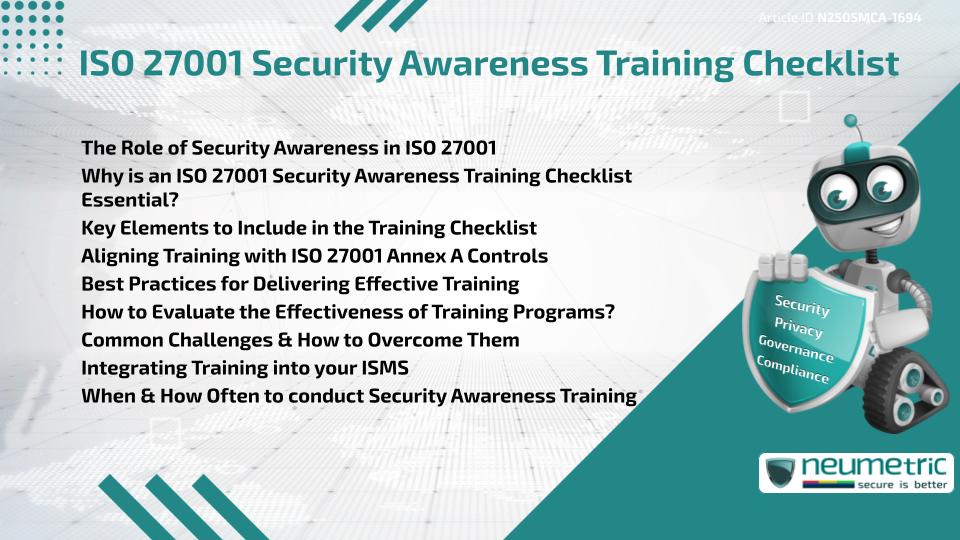Table of Contents
ToggleIntroduction
Security awareness training is not just a formality under ISO 27001—it’s a foundational requirement that supports a broader Information Security Management System [ISMS]. An effective ISO 27001 security awareness training checklist helps Organisations consistently educate their workforce, reduce human error & meet Compliance obligations.
In this article, we’ll explore why security awareness training is critical, what a checklist should include & how to apply it within your ISMS to improve security maturity.
The Role of Security Awareness in ISO 27001
The ISO 27001 Standard requires that personnel be aware of the relevance & importance of their activities & how they contribute to Information Security. This goes beyond technical training—it’s about building a mindset across the Organisation that recognises the value of Data Protection.
Training is particularly relevant to Annex A controls such as A.7.2.2 (Information Security Awareness) in which it mandates that all Employees must receive appropriate security awareness training.
Why is an ISO 27001 Security Awareness Training Checklist Essential?
Without a structured approach, training can become inconsistent, incomplete or outdated. An ISO 27001 security awareness training checklist ensures:
- Training content aligns with current Threats & Policies
- All relevant Employee roles are included
- Delivery is timely & traceable
- Documentation is Audit-ready
A checklist reduces uncertainty during audits & helps embed a strong security culture.
Key Elements to Include in the Training Checklist
An effective ISO 27001 security awareness training checklist should include:
- Policy Familiarity: Employees must understand internal Policies such as acceptable use, Access Control & Incident Response.
- Recognising Threats: Training on phishing, social engineering, password hygiene & data handling.
- Reporting Mechanisms: How to report incidents, suspicious behaviour or non-Compliance.
- Role-Specific Risks: Tailored content for IT, HR, Finance & leadership roles.
- Training Records: Logs of training completion dates, feedback & test scores.
Aligning Training with ISO 27001 Annex A Controls
The Training Program should map directly to relevant ISO 27001 controls. For instance:
- A.7.2.2: Mandates awareness education for all Employees.
- A.6.1.1: Internal responsibilities for security should be clear.
- A.12.2.1: It involves training around the malware protection & information exchange.
This alignment not only meets the Compliance checklist but also makes the training more effective by approaching the important Risk areas.
Best Practices for Delivering Effective Training
Here are Best Practices that help maximise the value of your ISO 27001 security awareness training checklist:
- Use Multiple Formats: Combine e-learning, emails, posters & workshops.
- Make It Engaging: Use storytelling & real-life scenarios to improve recall.
- Keep It Ongoing: Schedule refresher sessions every six (6) to twelve (12) months.
- Update Regularly: Review content post-incident or when regulations change.
Even small touches like quizzes or rewards can increase participation & retention.
How to Evaluate the Effectiveness of Training Programs?
Training is only useful if it results in changed behaviour. To measure this:
- Conduct Phishing Simulations: Track click-through rates & report timing.
- Review Incident Trends: Monitor whether human error–related incidents decline.
- Assess Awareness Surveys: Gauge Employee confidence in handling Threats.
- Check Audit Feedback: See if training effectiveness is questioned by auditors.
These data points will help you adapt your ISO 27001 security awareness training checklist based on actual performance.
Common Challenges & How to Overcome Them
Organisations often face challenges such as:
- Low Engagement: It rectifies by making training relatable & short.
- One-Size-Fits-All Content: Solve with role-based segmentation.
- Tracking Gaps: Use automated learning management systems to monitor Compliance.
Addressing these problems early helps to improve the training ROI & ensures sustained Compliance.
Integrating Training into your ISMS
Security awareness should not be a standalone initiative. It needs to be part of a larger Framework that includes Risk Assessment, Incident Response & continual improvement.
You can achieve this by:
- Embedding training into onboarding processes
- Linking it to Corrective Actions after incidents
- Including it in your annual Internal Audit checklist
This integration ensures that your ISO 27001 security awareness training checklist supports not only knowledge transfer but also long-term behaviour change.
When & How Often to conduct Security Awareness Training
Initial training should occur during Employee onboarding. Refresher training should be held:
- Annually, at a minimum
- After significant incidents
- When new Threats or technologies are introduced
- Following major policy updates
Timing is critical. Too infrequent & knowledge fades—too often & it becomes repetitive. Tailor your approach based on Risk Assessments & workforce needs.
Takeaways
- The ISO 27001 security awareness training checklist is essential for creating a proactive security culture.
- Training must be structured, frequent & aligned with specific Annex A controls.
- Tailored content, clear tracking & integration with ISMS processes are important.
- Measuring effectiveness helps evolve training to meet new challenges.
- A well prepared checklist simplifies audits & helps the overall security readiness.
FAQ
What Should Be Included in an ISO 27001 Security Awareness Training Checklist?
ISO 27001 should include training topics about Policies, Threat recognition, reporting procedures, role-specific content & documented evidence of participation.
How often should ISO 27001 security awareness training sessions be conducted?
At a minimum, it should be held once a year. Additional sessions may be needed after incidents or major policy updates.
Is role-specific training necessary?
Yes, Employees in different departments face different Risks. Its staff would need more technical training while HR may need Privacy & Compliance modules.
How do I prove that training has been completed?
Use attendance logs, quiz results, Employee attestations or learning management system reports to demonstrate completion.
Does ISO27001 specify the format of awareness training?
No, ISO 27001 allows flexibility. You can use in-person sessions, e-learning modules or even simulations depending on your organisational needs.
What happens if Employees skip security awareness training?
It could lead to Audit non-Compliance & increased security Risks due to unawareness of basic Threat response procedures.
Can security awareness training reduce incidents?
Yes, well-designed training reduces the chance of human error–related incidents like phishing or data leaks.
Should training materials be reviewed regularly?
Yes, updating content regularly ensures relevance & addresses new Threats or policy changes.
Need help?
Neumetric provides organisations the necessary help to achieve their Cybersecurity, Compliance, Governance, Privacy, Certifications & Pentesting goals.
Organisations & Businesses, specifically those which provide SaaS & AI Solutions, usually need a Cybersecurity Partner for meeting & maintaining the ongoing Security & Privacy needs & requirements of their Clients & Customers.
SOC 2, ISO 27001, ISO 42001, NIST, HIPAA, HECVAT, EU GDPR are some of the Frameworks that are served by Fusion – a centralised, automated, AI-enabled SaaS Solution created & managed by Neumetric.
Reach out to us!


